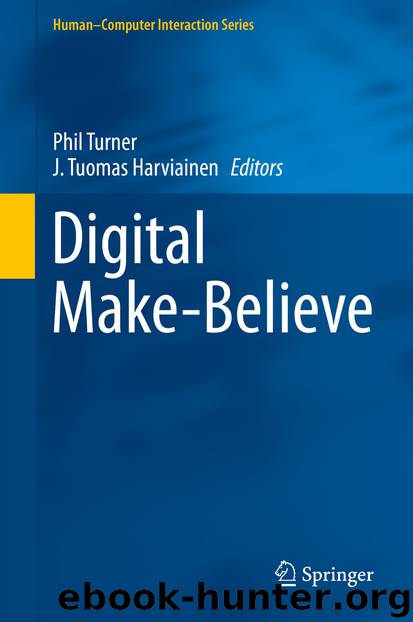Digital Make-Believe by Phil Turner & J. Tuomas Harviainen

Author:Phil Turner & J. Tuomas Harviainen
Language: eng
Format: epub
Publisher: Springer International Publishing, Cham
6.3 Props and Models in Gameworld Interfaces
How does the imaginative process work in the context of gameworld interfaces? According to Kendall Walton, props are important cues in the imaginative process. Props are “generators of fictional truths, things which, by virtue of their existence, make propositions fictional” (Walton 1990, 37), and anything that is being used in the imaginative process for the purpose of establishing and maintaining a fictional reality can be considered props. When something serves as a prop, it becomes a fictional representation in a game of make-believe. As world representations, gameworlds have the potential for employing, and for themselves being, props. Although Walton explicitly connects props to the activity of make-believe, props may support any kinds of imaginative process. Understood as a cue that guides our attention or supports our interpretative processes, they are helpful not only for fictional imagination, but also in processes of hypothetical reasoning and meaning-making associated with ludic imagination.
We find support in cognitive science for the idea that representations or objects may assist us, not only in the make-believe process, but also in other cognitive processes. Research in cognitive science has shown that we often use external models or artefacts are helpful for human cognition process of sense-making (Kirsh 2010; Scaife and Rogers 1996). The idea that representations and models may help us understand complex processes is fundamental both to the use of illustrations for explanatory or pedagogical purposes, and for the idea of training simulations and simulation-based learning. Scaife and Rogers argue that a particular way of representing an underlying structure will affect comprehension and problem solving. Models that visualize or put into motion how things work may reduce the cognitive effort required to understand what is being represented or solve a problem, and such models can also cue a particular interpretation of an abstract structure (1996, 188–189).
Using Walton’s terminology, the model or representation becomes in these cases a prop that allows the player to envision how the system works and can be interacted with, and thus it works to support the imaginative process. As the gameworld itself models the underlying, abstract game system in terms of a more comprehensible world environment, the gameworld is a prop that cues the player’s understanding of how the game system works. By exploring the gameworld and testing its interactive limits, the player uses the gameworld to envision possible scenarios and solve problems. Players stressing a ludic over a fictional mindset will approach the gameworld as a model that helps them understand how to interact with and master the game, and their imaginative process will stress problem solving rather than immersing themselves into a fictional reality.
When the player enters a gameworld that addresses them in a way that resembles the physical world, for instance through a recognizable topography and inhabitants that address them with tasks they can solve, he or she is given cues that strongly invite them to imagine this world as if it were real. Corresponding with the idea of a coherent fictional world, ecological
Download
This site does not store any files on its server. We only index and link to content provided by other sites. Please contact the content providers to delete copyright contents if any and email us, we'll remove relevant links or contents immediately.
Kathy Andrews Collection by Kathy Andrews(11678)
The remains of the day by Kazuo Ishiguro(8748)
Paper Towns by Green John(5024)
Spare by Prince Harry The Duke of Sussex(4996)
The Body: A Guide for Occupants by Bill Bryson(4887)
Industrial Automation from Scratch: A hands-on guide to using sensors, actuators, PLCs, HMIs, and SCADA to automate industrial processes by Olushola Akande(4846)
Machine Learning at Scale with H2O by Gregory Keys | David Whiting(3970)
Be in a Treehouse by Pete Nelson(3876)
Harry Potter and the Goblet Of Fire by J.K. Rowling(3737)
Never by Ken Follett(3704)
Goodbye Paradise(3666)
Into Thin Air by Jon Krakauer(3261)
The Remains of the Day by Kazuo Ishiguro(3254)
The Cellar by Natasha Preston(3220)
The Genius of Japanese Carpentry by Azby Brown(3190)
Fairy Tale by Stephen King(3156)
120 Days of Sodom by Marquis de Sade(3118)
Drawing Shortcuts: Developing Quick Drawing Skills Using Today's Technology by Leggitt Jim(2960)
The Man Who Died Twice by Richard Osman(2955)
